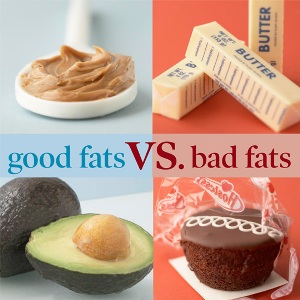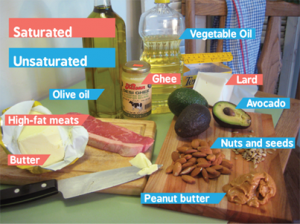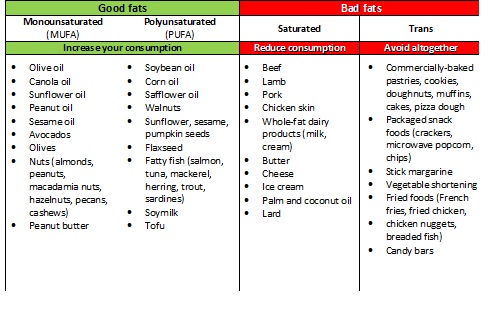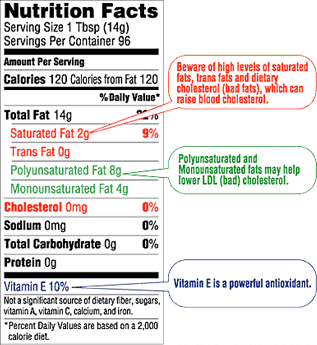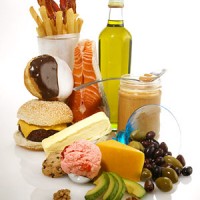 Welcome to week four of the Six Weeks to a Healthy Diet course. This week is all about learning the difference between good fats and bad fats and how to get the right fats into your diet.
Welcome to week four of the Six Weeks to a Healthy Diet course. This week is all about learning the difference between good fats and bad fats and how to get the right fats into your diet.
Week 4 – Choosing Fats Wisely
Fat is the substance in food that provides a rich texture and flavor. The foods that contain the largest amounts of fat come from animal products such as meat, dairy and eggs, plus nuts and seeds. Common examples of cooking fats include olive oil, lard, canola oil, butter, margarine and shortening.
You need to eat fats – good fats are necessary for a healthy body. But you also need to avoid some fats, the bad fats that raise your cholesterol and increase inflammation.
This week, I’ll teach you some tips on getting more good fats (and fewer bad fats) into your diet.
Fats have a number of important functions, which include:
- Lubrication of body surfaces Components of cell membrane structures
- Formation of steroid hormones
- Energy storage
- Insulation from cold Carrying fat soluble vitamins A, D, E, K
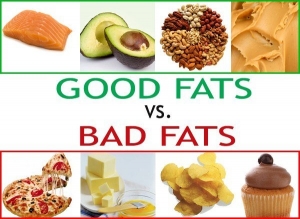 Good Fats vs. Bad Fats
Good Fats vs. Bad Fats
Some fats are better for your health than others. The polyunsaturated and monounsaturated fatty acids are generally good, and the saturated fats are bad. The largest amounts of polyunsaturated fats are found in plants, such as in seeds, nuts and vegetable oils. Fish and seafood are also rich in polyunsaturated fats. Olive oil, canola oil, avocado and nuts also contain monounsaturated fats, which are good for your heart and your blood vessels.
The bad fats included saturated fatty acids and trans-fats. People who eat large amounts of saturated fats from red meats tend to have higher cholesterol levels, more inflammation and are at a higher risk of cardiovascular disease. Trans-fats may even be worse. Most trans-fats are formed when hydrogen is forced into liquid vegetable oils to make them semi-solid. Some types of stick margarine contain large amounts of trans-fats and some highly processed foods have trans-fats. Some naturally occurring trans-fats are in dairy products; however, they don’t seem to be as detrimental as the trans-fats that are created artificially.
Eating a healthy diet means you need to eat fewer trans-fats and saturated fats and more of the poly and monounsaturated fats.
This week you’re going to work on both.
Reducing Fat in General
The USDA suggests that about 30% of your calories come from fats, but many people eat much more fat than that. You can start to reduce the fat in your diet by choosing low-fat and non-fat foods at the grocery store and by choosing recipes that are low in fat.
Generally, you should:
- Cut back on creamy sauces and oily dressings
- Avoid fried foods
- Stay away from highly processed foods (or at least read the labels to choose the products with the least amount of total fat)
- Don’t eat rich desserts that are high in sugar and fat
- Use non-stick cookware and non-stick cooking spray instead of butter and oils
- Choose baked chips and snacks that are lower in fat than regular chips.
Avoiding Saturated Fats and Trans-Fats
Red meat is high in saturated fats, especially the fattier cuts of meat and ground beef. Eggs, dairy products like cream, whole milk and cheese, tropical oils and coconut oil are also high in saturated fats. These aren’t “bad foods,” but you need to watch how much you’re eating of these products. Processed lunch meats, hot dogs, sausages and bacon are very high in saturated fats (and they contain chemicals that are bad for you), and should be avoided.
Here are some steps you can take to reduce your consumption of saturated fats:
- Choose non-fat or low-fat milk, yogurt and cheese every day
- Trim fat from red meats before cooking or choose lean cuts of meat
- Eat red meat just two or three times each week
- Remember that one serving of red meat should be about the size of a deck of cards
- Choose poultry (remove the skin), and fish more often.
- Bake, grill or broil poultry and fish, but don’t fry them
- Avoid foods that are battered and fried. They’re high in calories and bad fats
- Eat more legumes like dry beans, soy and lentils. They contain lots of protein and fiber, and no saturated fat
Trans fats can be avoided by choosing margarine that is not made with trans-fats (read the Nutrition Facts label -– it should show zero servings of trans-fat and the ingredients should not list “partially hydrogenated oils.” You should also avoid the highly processed foods like potato chips, tortilla chips and cheese snacks that are fried in trans-fats, or other snack items baked with trans-fats. Many of those snack items are high in sugar, so you gave them up in week two.
Olive oil is a well-known source of monounsaturated fatty acid and is a main component of the Mediterranean diet, which is associated with good health. Extra virgin olive oil is a good choice because it also contains phytochemicals called polyphenols that are beneficial for your body.
Canola oil, nuts, and avocados also contain some monounsaturated fats. Canola has a light flavor so it works well for cooking and baking. Nuts are also rich in protein and help to keep you feeling full between meals.
Here are some ideas for increasing the monounsaturated fats in your diet:
- Top a salad with olive oil and balsamic vinegar
- Drizzle olive oil on your favorite vegetables
- Add slices of avocado to salads and sandwiches
- Enjoy a handful of nuts as a mid-meal snack
- Add chopped nuts to a bowl of oatmeal, to your salad or on top of a vegetable side dish
Increasing Polyunsaturated Fats
There are two types of polyunsaturated fats called omega-3 and omega-6 fatty acids. Omega-3 fats are found in fish, chia seeds, flax, soy, walnuts and canola oil. Omega-6 fats are found in varying amounts in nuts, seeds, grains and vegetable oils. Most red meat is low in polyunsaturated fats, but animals raised on grass instead of corn-based feeds have meat that has more polyunsaturated fats and lower in fat in general.
You’re probably already eating plenty of the omega-6 fats, unless you’re eating a low-fat diet. The omega-6 fatty acids are common in a typical Western diet, but the omega-3 fatty acids are often deficient. Many experts believe that eating a diet with too many omega-6 fats and too few omega-3 fats increases your risk for inflammation and chronic disease.
You can correct that imbalance that by choosing more omega-3 fatty acids:
- Choose canola oil instead of corn oil or safflower oil for cooking and baking
- Sprinkle milled flax seeds on your salads
- Take a tablespoon of flax seed oil as a daily supplement
- Eat fish two or three times per week.
- Salmon, tuna, and trout are all rich in omega-3 fatty acids
- Soy is rich in protein and omega-3 fats.
- Try tofu in a stir-fry
- Enjoy walnuts or pumpkin seeds as snacks. Both contain substantial amounts of omega-3 fatty acids
So this week you’re going to focus on two things – reduce the bad fats and increase the good fats.
Are you still using your diary? Take a look at the fats in your diet. For this week’s assignment, I want you to reduce the bad fats and replace them with good fats.
Choose a goal this week that works for you.
Here are two examples:
I will eat fish, skinless chicken or a vegetarian meal instead of my usual fatty red meat, three or more meals this week.
I will choose one ounce of nuts as a snack three days this week.
Your next lesson will help you learn more about whole grains and why they’re so good for you.
Next Lesson: Six Weeks to a Healthy Diet Week 5 Whole Grains
Choosing Fats Wisely Quiz
Think you got it all down? Take this quiz to make sure you are ready to move on to lesson five next week.
1) You should avoid nuts because they’re so high in calories.
a. True
b. False
2 You should eat as little fat as possible.
a. True
b. False
3) Trans-fats reduce your risk of heart disease.
a. True
b. False
4) Nuts are a source of good fats.
a. True
b. False
5) Extra virgin olive oil has polyphenols that are good for your health.
a. True
b. False
6) Almost everybody should eat a lot more omega-6 fatty acids every day and fewer omega-3 fatty acids.
a. True
b. False
7) You should be getting about 30 percent of your calories from fat.
a. True
b. False
8) Choose the best option.
a. Ground beef
b. Sausage
c. Skinless chicken breast
d. Bacon
9) Which of these fats is bad for your heart?
a. Olive oil
b. Saturated fat
c. Omega-3 fatty acids
d. None of the above
10) Which food is rich in omega-3 fatty acids?
a. Salmon
b. Tuna
c. Trout
d. All of the above
Choosing Fats Wisely Answers
1) You should avoid nuts because they’re so high in calories. The correct answer is “b” False.
2) You should eat as little fat as possible. The correct answer is “b” false
3) Trans-fats reduce your risk of heart disease. The correct answer is “b” False.
4) Nuts are a source of good fats. The correct answer is “a” True.
5) Extra virgin olive oil has polyphenols that are good for your health. The correct answer is “a” True.
6) Almost everybody should eat a lot more omega-6 fatty acids every day and fewer omega-3 fatty acids. The correct answer is “b” false.
7) You should be getting about 30 percent of your calories from fat. The correct answer is “a” True.
8) Choose the best option. The correct answer is “c” Skinless chicken breast
9) Which of these fats is bad for your heart? The correct answer is “b” Saturated fat
10) Which food is rich in omega-3 fatty acids? The correct answer is “d”All of the above .

